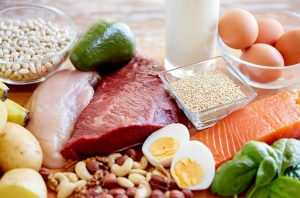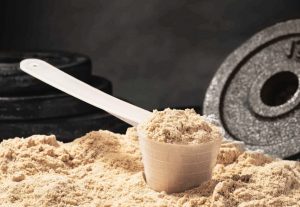Ideal protein content to counteract sarcopenia:
Durante il progetto SPRINTT è emerso come risorse alimentari sbagliate, ovvero carenti di proteins, have a particularly strong influence on muscle exhaustion.
The SPRINTT project, in fact, has fixed 1.2 grams of protein per kg of body weight, the ideal quantity of proteins, in order to counteract the phenomenon of sarcopenia from a food point of view.
The SPRINTT project (Sarcopenia & Physical fRailty IN older people: multi-componenT Treatment strategies) involved 80 researchers from 11 European countries, 16 research institutes, and over 1,500 patients over 70 monitored for 22 months. This is the 1st large-scale European collaborative research project to combat aging.
Constant protein and amino acid mixtures
Protein blends, or those supplements, which contain several protein sources in a single product, are able to ensure a constant and progressive amino acidemia.
And now I try to explain in a simple and clear way what I have just stated:
First of all it should be considered that, once a protein source (of any type) is introduced, it is reduced to its basic structure, that is to the amino acids that compose it, and the amino acids obtained will be used to perform protein synthesis.
With the term protein synthesis, we mean, among other things, also the building and maintenance of muscle mass. Always consider that the building of lean mass is the best known, but it is only one of the functions of proteins.
Each protein source has its own precise assimilation time, EXAMPLE:
Our body takes a very short time to reduce and assimilate the amino acids that form the proteins hydrolyzed whey.
While it takes much longer to reduce and assimilate the amino acids that form the proteins of caseins.
Having, in the same product, proteins rapidly absorbed, together with slower absorbed proteins (this is the case with protein mixtures), it ensures that the "amino acidic assets" of the proteins more rapid, then, in sequence, than the less rapid ones.
This allows for a constant and progressive release of amino acids in the blood, that is, a constant and progressive amino acidemia, in order to allow a prolonged protein synthesis over time.
It should be considered that, one protein "Rapid" is particularly indicated in order to build new muscle mass, while a protein "Slow" is particularly suitable for maintaining existing muscles.
Always as long as they are protein sources with a good amino acid profile.
The advantage of protein blends lies in the fact that they are suitable for both building new muscle mass and maintaining existing one.
The age of sarcopenia:
There is no precise and defined age at which the phenomenon of sarcopenia.
There are various factors, such as a sedentary lifestyle, and poor eating habits, which can induce the sarcopenia to manifest itself even in individuals of only 40 years of age.
In less sedentary subjects, and more careful in nutrition, the sarcopenia it will arrive on average around 50 years.
First the sarcopenia it will manifest itself in a very mild way, there will be a period of about 10 years in which it will gradually increase in intensity.
From the age of 60 onwards, the sarcopenia it will manifest itself more heavily.
Aging is a natural and inevitable process, so it is inevitable that the sarcopenia show up, then it's up to us to decide if we want to age well or badly.
To effectively counter the sarcopenia, so age well, just exercise, and follow a diet rich in proteins, but also mineral salts and vitamins, anti oxidants and omega 3 fatty acids.
All of this means that we can follow a very varied diet, which allows us to eat healthy foods while taking care of ourselves, and making life hard for us. sarcopenia.
Anti sarcopenia food tips:
The anti diet sarcopenia must first of all provide a good protein intake, and the proteins we can introduce them both from animal sources, for example meat, fish, eggs, and from vegetable sources, for example legumes.
In this regard, however, an important clarification must be made:
The proteins of animal origin have a much higher biological value than proteins of vegetable origin.
This does not mean that they must be taken only and exclusively proteins of animal origin, but that in the case of vegetable protein sources, different protein sources must be taken together.
This will allow our body to make a good protein synthesis.
Just to give an example that we all know, let's consider a typical dish of the popular tradition, such as pasta and beans.
Pasta and beans contain a concept that takes the name of mutual amino acid compensation, from complementary protein sources.
In practice, the amino acids present in small quantities in one protein source are present in large quantities in another, and putting them together we obtain an amino acid profile that ensures good protein synthesis.
This is why they are called complementary protein sources.
In the specific case of pasta and beans, pasta has a small amount of the amino acid Lysine, but borlotti beans contain a lot of it.
Eating pasta and beans means compensating for the lack of the amino acid profile of the pasta, with the abundance of lysine in the beans.
And in this way we guarantee our body the possibility of making a good protein synthesis.
After this little parenthesis, now let's go back to talking about other foods that must not be missing in the anti diet sarcopenia:
In addition to containing a good percentage of proteins, fish, also contains very important omega 3 fatty acids.
And the fish that are richest are cod, salmon, tuna, and mackerel.
Equally important are vitamins and minerals, so let's not miss out on fruit and vegetables.
We can eat carbohydrates, as long as they have a low glycemic index, such as barley, spelled, and oats; carbohydrates are our primary fuel, they should not be demonized: our body sees them as a real energy package. If a carbohydrate is low on the glycemic index, it means that it is a slow-release "energy pack".
Fiber is also important, which we can find in beans, chickpeas, peas, lentils.
Tomatoes and spinach are valuable natural antioxidants, as are omega 3s.
For dressing we use olive oil, and please try to limit the consumption of sugar, butter, alcohol, and industrial snacks.
This short list is just a small example of how it is possible to eat well, which means taking care of yourself, and counteracting the sarcopenia.
Read also:
Proteins: biological value and protein sources






